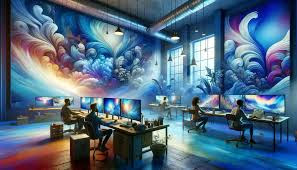Using Midjourney for Game Development: Unlocking Creative Possibilities
In the dynamic world of game development, visuals play a crucial role in creating immersive, captivating experiences for players. Whether it’s the design of a sprawling fantasy world, the detailed features of a futuristic cityscape, or the unique aesthetic of characters and creatures, having strong visual assets can make or break a game. With the rise of AI-powered design tools, MidJourney has emerged as a powerful solution for game developers looking to enhance their creative workflows and streamline visual production.
Here’s how MidJourney can be a game-changer for game developers.
1. Rapid Prototyping & Concept Art
One of the most time-consuming stages of game design is prototyping, especially when it comes to developing concept art for characters, environments, and objects. Artists typically spend hours or even days sketching out ideas, iterating on feedback, and refining designs.
With MidJourney, game developers can generate high-quality concept art in a fraction of the time. By feeding in descriptions of what you're looking for—whether it’s a mystical forest, a cyberpunk metropolis, or a heroic character—MidJourney’s AI can generate visuals that closely match your ideas. This enables developers to rapidly prototype different looks and styles, cutting down on manual sketching and speeding up the creative process.
2. Bringing Unique Aesthetic Styles to Life
MidJourney has a knack for creating visually unique and stylized artwork that stands out from traditional design tools. Its ability to generate a wide range of artistic styles, from hyper-realistic to abstract, can inspire and even dictate the aesthetic direction of a game.
Developers can experiment with different art styles using prompts and adjust visuals to match the tone of the game. Want your game to have a surreal, dreamlike look? Or perhaps a gritty, dystopian atmosphere? With MidJourney, the flexibility to explore new aesthetics is at your fingertips, potentially sparking new creative ideas that you may not have considered before.
3. Efficient World-Building
World-building is one of the core aspects of game design. From sprawling landscapes to detailed interior environments, the visual intricacy of a game's world enhances the player’s immersion. MidJourney can assist developers in creating detailed environments faster by generating a variety of concept designs based on textual input.
For example, inputting a prompt like "post-apocalyptic desert city with crumbling skyscrapers" can yield multiple artistic interpretations of that world. Developers can then build on these visuals, using them as a foundation for 3D modeling or to inspire narrative elements.
4. Boosting Creativity in Character Design
Characters are the heart of many games, and MidJourney can help bring unique and compelling characters to life. With the right prompt, developers can generate characters with distinct visual identities, from quirky NPCs to fierce main protagonists.
MidJourney’s AI-generated characters can serve as early design inspirations, allowing teams to visualize how certain traits or attributes will translate into the game’s world. This can be especially useful for indie developers with limited resources, helping them quickly iterate on character designs before settling on a final look.
5. Iterating on Feedback Quickly
Games go through multiple rounds of revisions, and visuals are often reworked based on feedback from developers, stakeholders, or players. In traditional pipelines, this can lead to bottlenecks, especially when time is limited. With MidJourney, feedback can be integrated into the design process much more efficiently.
By simply updating the text prompts, MidJourney can generate new iterations of a design almost instantly. This enables teams to cycle through revisions at a faster pace without putting extra strain on artists.
6. Accessibility for Indie Developers
Large game studios often have dedicated teams of artists, designers, and 3D modelers working on their visual assets. Indie developers, on the other hand, usually don’t have that luxury. MidJourney’s affordability and ease of use make it an attractive option for smaller teams who want to elevate the quality of their visual content without hiring a full art team.
MidJourney can also serve as a supplementary tool to enhance the work of artists, providing them with inspiration or helping them test visual ideas faster.
7. Fostering Collaborative Creativity
MidJourney can be an exciting addition to a collaborative game development environment. Teams can generate visuals together, experiment with different artistic directions, and collectively decide on the best aesthetic approach. Since the tool relies on written prompts, it encourages open communication about what type of visuals are desired, ensuring everyone on the team can contribute their creative ideas.
Final Thoughts
MidJourney’s AI-driven approach is helping to democratize game design, making high-quality visual assets more accessible to developers of all sizes. Whether you're prototyping environments, designing characters, or experimenting with different art styles, MidJourney can be a valuable tool to enhance creativity, reduce production time, and ultimately bring fresh, exciting ideas to life in your game.
By leveraging the power of AI, MidJourney is opening up new creative possibilities that were previously limited by time, resources, and artistic capability. For developers looking to create visually striking and unique gaming experiences, the journey starts here.
For more topics, see https://bleedingedge.studio/blog/
.jpg)
.png)

Comments
Post a Comment